Boiling function in the washing machine
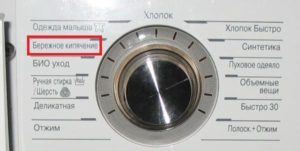 To remove old stains from light-colored fabrics, many housewives resort to “hot” bleaching - boiling the laundry. And everything happens the old fashioned way: water is boiled in pots, after which things are put into boiling water and “cooked” for several minutes. And not everyone knows that you can boil clothes directly in the washing machine.
To remove old stains from light-colored fabrics, many housewives resort to “hot” bleaching - boiling the laundry. And everything happens the old fashioned way: water is boiled in pots, after which things are put into boiling water and “cooked” for several minutes. And not everyone knows that you can boil clothes directly in the washing machine.
There is not always a special boiling mode in the washing machine, but even without it the machine is able to warm up to the required degrees. The main thing is to set up the cycle correctly.
Can all machines boil?
Almost any washing machine can boil water. The only exceptions will be models that are too old, and the problem is not in the functionality, but in the condition of the heating element - over time, it becomes overgrown with scale and works poorly. Other machines heat up to temperatures close to boiling without any problems. To make sure, just look at the temperature scale of the machine - a maximum of 90-95 degrees is written there. No more is needed for the fabric.
The special “Boiling” mode is found only in a few modern machines. Simple models heat up to maximum temperatures using 1-2 standard programs. Most often it is “Cotton”, “Preliminary” or “Intensive wash”. To boil water and bleach laundry in such machines, you need to:
- activate any high temperature cycle;
- set the heating temperature to 90 or 95 degrees;
- add oxygen bleach to the powder receptacle;
- start the wash.
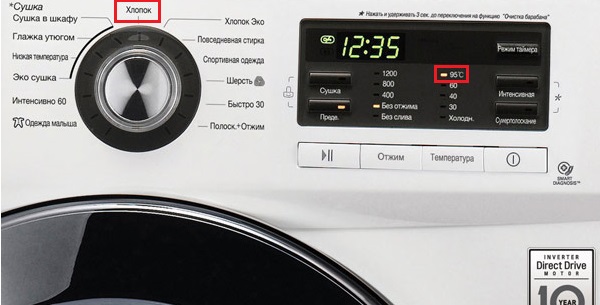
On a high-temperature program, the machine takes a long time to wash.During boiling, the drum rotates slowly and constantly stops to ensure even heating of the water and mix the laundry with detergent. At maximum degrees, the washing machine lasts about 20-25 minutes, which is enough to whiten the fabric. Some models “boil” longer - it all depends on the algorithm specified by the manufacturer.
Experts recommend boiling laundry in the washing machine no more than once a month.
After boiling, the program smoothly switches to rinsing and spinning. Reheating does not occur - the washer rinses in cold water.
It is not recommended to frequently activate the boiling function on the washing machine. Heating water above 60 degrees puts additional stress on the components and devices of the machine. The main blow is taken by the heating element itself, as well as the oil seal, bearings, rubber seals, tank and pump. It’s better not to take risks and turn on high-temperature washing a maximum of 1-2 times a month.
The machine does not boil
Sometimes the washing machine “refuses” to heat up to a boil. There are two options: the machine does not heat up at all or does not reach the degrees specified by the user. In any case, the heating element is to blame. It burned out, became covered with scale, or lost connection with the board.
If you suspect a malfunction of the heating element, it is necessary to diagnose it - “ring” it with a multimeter. But first you need to find the device. The location of the element depends on the manufacturer. So, on Indesit, Samsung, Beko and Ariston washing machines it is discharged into the tank from the back, and on Bosch and Siemens - from the front. It’s better not to guess, but to look at the electrical diagram for connecting the heater in the factory instructions.
You can determine the location of the heating element without instructions. The procedure is as follows:
- look at the back panel of the case (if the back is large, it means the heating element is located at the back);
- put the machine on its left side and look into the bottom (so you can see the heater);
- remove the back panel and inspect the washing tank (the “chip” with wires at the bottom of the tank is the heating element);
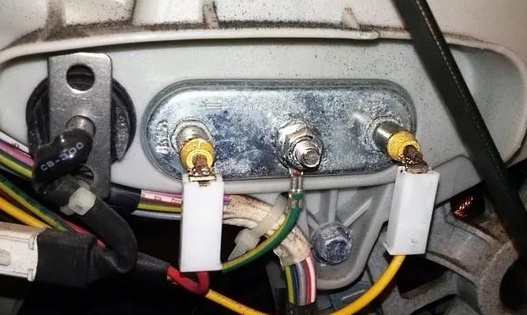
- try to see the heater through the drum (you will need a flashlight and good eyesight).
A tubular electric heater fails due to voltage surges and hard tap water.
You need to look for heating elements in the washing tank, which greatly simplifies the task. In this case, you do not need to dismantle the device - you can ring the element without removing it.
Heater diagnostics proceed in the following order:
- the machine is disconnected from the power supply and water supply;
- access to the heating element is freed (the pan or back cover is removed);
- the location of the contacts on the element is photographed;
- the wiring from the heater chip is disconnected;
- take a multimeter and set it to measure resistance (set the value to 200 Ohms);
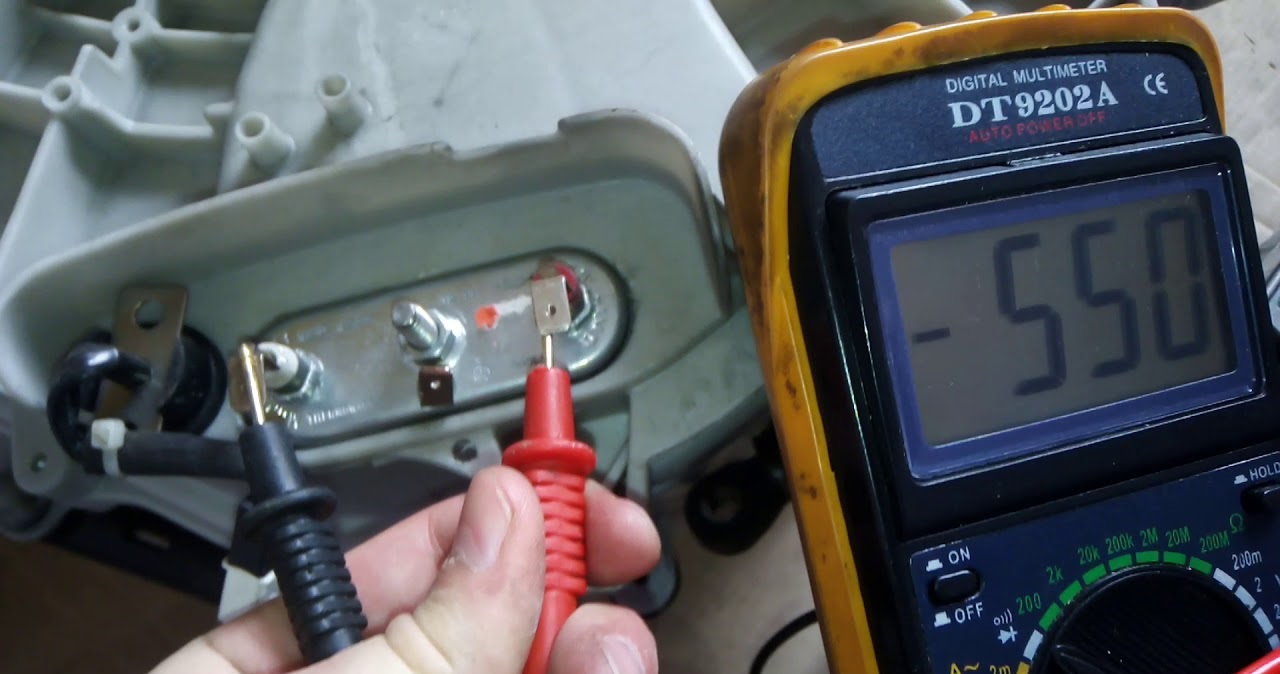
- probes cling to contacts;
- indicators are assessed.
Normally, the heating element produces 26.8 Ohms. Deviations within 21.8-31.8 Ohms are allowed. If the device shows “1”, it means the line is broken and the heater needs to be replaced. When “0” or another number less than 1 is displayed, a short circuit has occurred with subsequent burnout of the contacts.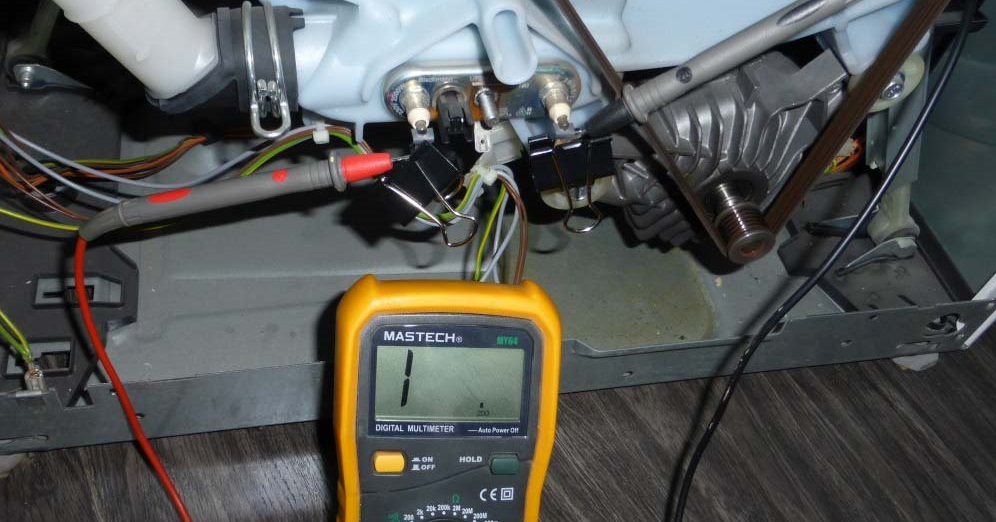
In addition to measuring the resistance, it is recommended to test the heater for breakdown. The fact is that the dielectric located in the device often “leaks” to the housing and provokes a current leak. At the same time, everything is clean on the outside, but the element does not work and is dangerous. To make sure the heating element is working properly:
- set the multimeter to buzzer mode;
- attach one clamp to the contact, and the second to the tester body;
- listen: a squeak will signal a breakdown.
A faulty heating element cannot be repaired - only replaced. The new heater is selected according to the serial number of the washing machine or according to the old model. The element is connected in the reverse order. To boil clothes in a washing machine, you don’t need to buy an extremely expensive machine with a special option. You just need to turn on the high-temperature program with maximum heating.
Interesting:
Reader comments
- Share your opinion - leave a comment
Categories
Washing machine repair


For buyers

For users

Dishwasher


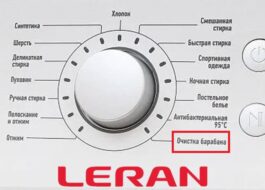



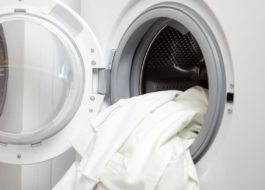










Add a comment